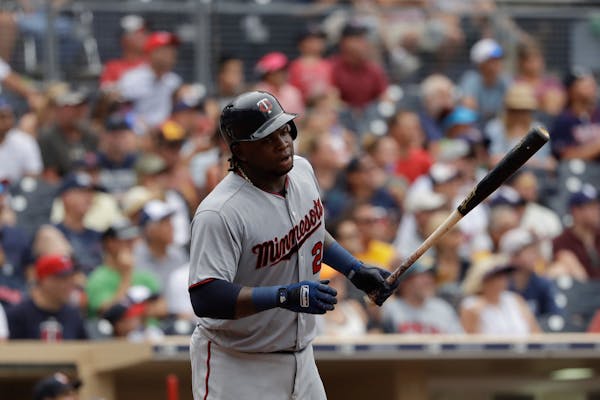In the footnotes of all that happened during this year's World Series — from Sports Illustrated seemingly predicting this three years ago to Carlos Correa proposing after his Astros won Game 7 — there is one that seems to be lingering for Twins fans.
George Springer, the biggest hitting hero in an Astros lineup full of them, was named World Series MVP after belting five home runs in the seven games against Los Angeles. This came after a very good regular season in which the 28-year-old outfielder hit 34 home runs and was named an All-Star.
Springer was a first-round pick of the Astros back in 2011 (11th pick overall) and is one of several home-grown stars that endured the organization's painful rebuild.
But three years before he was a first-round pick out of the University of Connecticut, Springer was drafted out of high school — also in Connecticut — by the Twins in the 48th round of the 2008 draft (image from the Star Tribune in 2008 pictured above dug out by colleague and friend Brian Stensaas).
This little bit of trivia has caused plenty of people to ask — some jokingly, some half-jokingly, some quite seriously — whether the Twins erred in not signing Springer and allowing him to instead enroll in college. The fact that the 2008 draft was the first one presided over by unpopular former GM Bill Smith has added a little fuel to whatever fire that burns.
But while it is tempting to think of what Springer's presence would mean to the current Twins, we also need a dose of reality here. The best way to do that is to provide a little context on the MLB draft.
*First off, the 48th round of the draft is such a long-shot position that it doesn't even exist anymore. In 2012, the MLB draft went from 50 to 40 rounds. So anyone chosen that late in the draft is a long shot of long shots and wouldn't even be picked today.
*The bonus money allotted to a 48th-round pick would, in most cases, be pretty marginal. Teams can exceed typical figures if they really like a player and want to persuade him — as would have been the case with Springer — to sign instead of going to college. But that late in the draft, a player with the chance to play for a Division I school is probably going to go that route in hopes of 1) getting an education and/or 2) playing well enough in college to enhance his draft stock once he's eligible to be drafted again, which happens either after he's been in college for three years or he turns 21 (whichever comes first).
*To give you some context about the success rate of players drafted in the 48th round: The Twins have made a 48th-round draft pick 27 times in their franchise history. Springer is the only one who has ever appeared in a major league game.
*More context: I went back and looked at the final 15 years of history of MLB drafts before it shrunk to 40 rounds (1997-2011) to see how 48th-round picks panned out.
Teams made a combined 380 picks in the 48th rounds of those drafts (some opting in some years to not even bother making a selection). Of those 380 picks, 21 reached the majors — most for limited action.
Only three players went on to achieve a lifetime Wins Above Replacement of more than three: Springer, Tim Lincecum (2003) and Seth Smith (2001). Lincecum, of course, was a two-time Cy Young winner. Smith has been a solid MLB hitter for a decade. And all three went to college after being drafted in the 48th round out of high school, eventually being taken much higher (Springer and Lincecum in the first round, Smith in the second round) by different teams.
So unless you expect the Twins to have the incredible foresight to see how great Springer would become as a 48th round pick and made him an offer he couldn't refuse, they didn't mess up. They did what every other team does: took a flier on a kid who didn't sign. Most of those players are barely heard from ever again. Springer is the 1 in 100 (or so) case that truly made an impact.

After Wild miss playoffs, who will stay and who will go?

